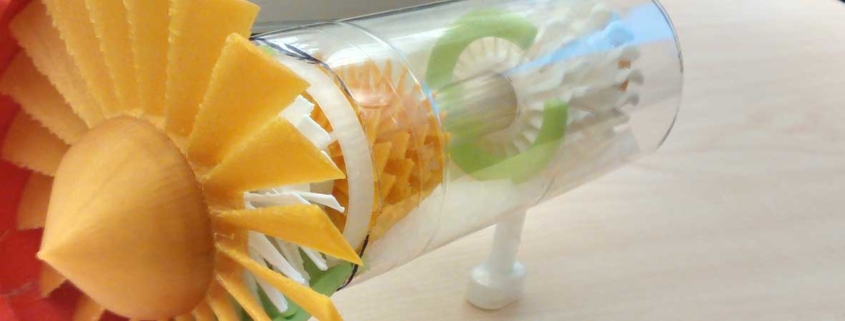Use Ultrasonic Energy to Remove 3D Printing Mold Support
Ultrasonic cleaning is fast and safe way to remove mold support and other surface contaminants from simple and complex 3-D printed parts. Results are far superior to time-consuming water soaking and the risk of possibly damaging part geometries if manually cleaned using brushes. Here you’ll learn how 3-D printed parts are made, then how ultrasonic energy is used to remove 3D printing mold support from your parts.
How 3-D Printed Parts are Made
3D part printing techniques use a variety of plastics and resins. Examples include ABS, PLA, polyamide (nylon), glass filled polyamide, stereolithography materials (epoxy resins), silver, titanium, steel, wax, photopolymers and polycarbonate.
A popular technique combines two moldable thermoplastic formulations such as ABS for the part itself and PLA for removable mold support. This is a quick means to produce highly complex configurations.
In this instance a key to the efficiency of the process is fast, safe removal of the PLA mold support without risking damage to the ABS part. An ultrasonic cleaner is proven far faster, safer and more effective than water sprays or manual scrubbing.
Other techniques called SLA (stereolithography) and LFS (low force stereolithography) use lasers to build the part without the need of mold support. In these cases uncured resin on the finished product requires removal best accomplished by ultrasonic energy.
A Two-Step Approach to Ultrasonic Cleaning 3-D Printed Parts
Here you need to make two decisions. The first is selecting an ultrasonic cleaning unit large enough to accommodate your 3-D printed parts in such a way that they are fully immersed. Some examples are provided later in this post.
The second point is the cleaning solution formulation.
Cleaning solution formulations for removing mold support and/or uncured resin from your 3D printed parts may vary depending on the composition of the material being removed.
One approach may involve a highly alkaline or caustic solution with a detergent serving as a wetting agent. Once the formulation is determined there is a fairly standardized procedure for removing mold support following the formulation directions.
Another instance, exemplified by wax, may call for flammable solvents with low flash points. Still others, such as LFS, may involve high flash point solvents or semi-aqueous solutions that contain solvents.
Options and Procedures for Cleaning 3-D Printed Parts
Here are options offered by Tovatech for setting up your cleaning system for 3-D printed parts.
1. Clean Small Parts with Flammable Solvent in Beakers
This may be the most practical solution for cleaning relatively small parts such as jewelry, dental implants and similar items using a volatile solvent such as isopropanol (IPA). It uses a conventional benchtop ultrasonic cleaner such as the 37 kHz Elmasonic EP, S or P unit with an accompanying beaker kit.
In this instance you can use tap water with a surfactant such as a few drops of dishwashing liquid in the ultrasonic cleaning tank. Before proceeding further remember to degas the solution by either activating the degas mode if so equipped) or running the cleaner for about 10 minutes without a load.
Situate the ultrasonic cleaner in a well-ventilated area. The ventilation system must ensure that the flammable vapor cannot reach an ignitable concentration near the ultrasonic tank. Check with your plant safety personnel and local fire regulations for the maximum quantity of flammable solvent that may be treated in an open ultrasonic tank.
Carefully place your 3-D printed parts in the beaker and add just enough solvent to ensure they are fully immersed. Loosely cover the beaker to minimize solvent evaporation
You can also use small, fine mesh screen baskets containing the parts and set into the beaker. In this case the small baskets must be such that you can cover the beaker.
In either case, the bottom 1-2 inches of the beakers should be immersed in the water. The ultrasonic energy will penetrate the glass walls and cavitation action will occur in the solvent, thus cleaning your parts.
At the conclusion of the process carefully remove the parts which, when dry, will be residue free.
2. Ultrasonic Cleaning Larger 3-D Parts Using High Flash Point (>100⁰C) Solvents
For cleaning larger parts using high flash point solvents (> 100°C) you can use a benchtop ultrasonic cleaner with capacities to 7.5 gallons such as the 37 kHz Elmasonic P180H and P300H.
The tank is partially filled with water with a surfactant, and the tub is placed in contact with the water. This is a safety precaution in the unlikely event the tank develops a leak that would allow the solvent or solution to reach internal electronics.
Parts to be cleaned are placed in mesh baskets and lowered into the cleaning solvent. Examples of high flash point solvents used in 3-D printing operations include dimethyl adipate and TPM (tripropyleneglycol methyl ether), both with flash points greater than 100 C.
This is followed by rinsing with clear water.
A Note on Ultrasonic Cleaning and Heat
Energy that produces ultrasonic cavitation, the process that does the cleaning, generates heat which cause solvents to evaporate. This can be controlled by installing cooling coils in smaller benchtop units and by capping the solvent beakers and observing placement cautions noted above.
Contact Tovatech
As suggested in this post options are available for hobbyists and manufacturers to clean 3-D printed parts. Selecting an ultrasonic cleaner and cleaning solvent will be based on the size of your products and the specific materials used in the printing process.
Of particular importance during cleaning cycles is careful adherence to safety precautions when using solvents. Please contact our scientists. We will be glad to discuss your operations and requirements, and to suggest an ultrasonic cleaning unit and cleaning solution best meeting your requirements.



